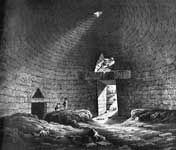|
|

Beehive tombs, also known as Tholos tombs (plural tholoi), are a monumental Late Bronze Age development of either the Mycenaean chamber tombs or tumulus burials dating to the Middle Bronze Age. The origins and development of the Beehive tombs is disputed with some supporting an origin in Messenia others in the built tholos tombs of Early Bronze Age Crete (despite some important differences both in function and form). After about 1500 BC, beehive tombs became more widespread. They were built as corbelled arches, layers of stone placed closer together as the arch tapers toward the top of the tomb. This style is probably an influence from Minoan tombs. The tombs usually contain more than one burial, in various places in the tomb either on the floor, in pits and cists or on stone-built or rock-cut benches, and with various grave goods. After a burial, the entrance to the tomb was filled in with soil, leaving a small mound with most of the tomb underground. The tripartite structure of the tombs is not always evident in the earliest mainland examples (for example at Voidhokoilia) but by the time the architectural type had left Messenia the separation into chamber, stomion and dromos was fixed. The chamber is always built in masonry, even in the earliest examples, as is the stomion or entrance-way, which provided an opportunity for conspicuous demonstration of wealth. The dromos was often just cut from the bedrock, even in some of the earlier examples at Mycenae itself. In later examples, all three parts were constructed of fine ashlar masonry. The abundance of such tombs, often with more than one being associated with a settlement during one specific time period, may indicate that their use was not confined to the ruling monarchy only, although the sheer size and therefore outlay required for the larger tombs (ranging from about 10 meters to about 15 meters in diameter) would argue in favour of royal commissions. The larger tombs contained amongst the richest finds to have come from the Late Bronze Age of Mainland Greece, despite the tombs having been pillaged both in antiquity and more recently. There are also recorded Etruscan tombs with a beehive style with decorated interior. The earliest stone-built tombs which can be called 'beehive', are in Oman, built of stacked flat stones which occur in nearby geological formations. They date to around 3,500 years BC, to a period when the Arabian peninsula was subject to much more rainfall than now, and supported a flourishing civilisation in what is now desert, to the west of the mountain range along the Gulf of Oman. No burial remains have ever been retrieved from these 'tombs', though there seems no other pupose for their building. Retrieved from "http://en.wikipedia.org/"
 |
|
|||||||||||||||||